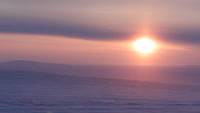Inuit seek answers to Arctic sun quirks
Source: cbc.ca
Some Inuit say they hope scientists coming to Nunavut for research as part of International Polar Year can help shed light on changes they're seeing in the sun — particularly, how it's been showing up more often in the usually always-dark winters.
For the past several years, residents in the High Arctic have observed that the winter dark season is ending earlier than usual, with the sun coming up at a different place than what people are used to seeing.
"The people [are] talking about earlier sunrise, more light in the dark season, instead of being more total darkness than before," Grise Fiord resident Larry Audlaluk said Thursday, adding that he has heard similar observations from people in other Far North communities.
"There are notices of more daylight earlier, and the dark season is not the real dark season that we used to know."
A bit further south, Igloolik Mayor Paul Quassa said hunters have noticed the same phenomenon.
"This year, the sun started coming up so fast that it's almost like April when it's mid-February," he said.
Both Audlaluk and Quassa were part of an International Polar Year planning workshop Thursday in Iqaluit.
Wayne Davidson, who is the resident meteorologist in Resolute Bay, said the likely cause of this "rising sun" mystery is a temperature difference between the very cold air over the snow and the air above, which has been warmer than usual.
Glaciologist Dr. Roy Koerner, with the Geological Survey of Canada, agreed, comparing it to sticking a fork into a glass of water: the fork appears to bend where it enters the water, he said.
"So you get the same effect: you get this bent effect. Except in this case, the sun, which is just below the horizon, looks as if it's above the horizon, just a bit of it," he said.
Both Koerner and Davidson said they believe a warming climate is responsible. They said they hope Inuit and scientists working during International Polar Year can work together on more in-depth analysis of the observations.
Article from: http://www.cbc.ca/technology/story/2007/03/09/nu-sun.html























